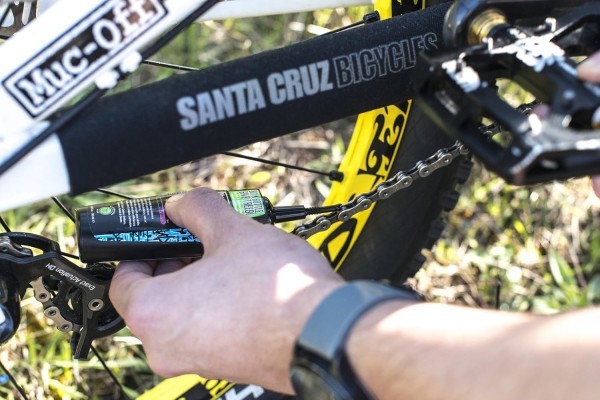We’ll show you how to clean your bike chain like a pro mechanic. No need to panic, it’s easier than you think! By following a few simple steps, you’ll have your bike chain looking and performing like new in no time. So grab your tools, roll up your sleeves, and let’s get started on giving your bike chain the love and attention it deserves. Get ready to ride with a smoother, more efficient chain that will have you gliding down the road or trail with ease.

1. Gather the Necessary Tools
First, gather the necessary tools to clean your bike chain like a pro mechanic.
To effectively clean your bike chain, you’ll need the following tools:
- A chain cleaner tool: This is essential for removing the built-up dirt and grime from the chain. It typically consists of brushes and a reservoir for the degreaser.
- A degreaser: This is used to break down the grease and dirt on the chain. You can use a specific bike chain degreaser or a mild household degreaser.
- A stiff-bristled brush: This is necessary to scrub off the stubborn dirt and grime from the chain.
- A cloth or rag: This is used to wipe off excess degreaser and dry the chain.
- A lubricant: This is required to ensure smooth and efficient performance of the chain. Choose a lubricant specifically designed for bike chains to ensure optimal results.
2. Preparing Your Bike for Cleaning
To prepare your bike for cleaning, gather all the tools mentioned in the article. These tools include a chain cleaner, a degreaser, a brush, a chain lubricant, and a rag.
Start by placing your bike on a stable surface, such as a bike stand or a sturdy table. Shift the chain onto the smallest chainring and the smallest rear cog to relieve tension. This will make it easier to remove the chain for cleaning.
Use a quick link or chain tool to disconnect the chain from the derailleur. Once the chain is removed, inspect it for any signs of damage or wear. If necessary, replace the chain with a new one.
3. Removing the Chain for a Thorough Clean
To begin removing the chain for a thorough clean, you’ll need to carefully disconnect it from the derailleur using either a quick link or chain tool.
First, shift your bike into the smallest chainring and smallest rear cog to relieve tension on the chain. Locate the quick link, a special link that can be easily disconnected by hand. You’ll need to use a chain tool if your chain doesn’t have a quick link.
Insert the chain tool pin into the chain link and turn the handle clockwise until the pin pushes the link out. Once the link is disconnected, carefully remove the chain from the derailleur and set it aside for cleaning. Remember to handle the chain with care to prevent any damage.
4. Cleaning the Chain With the Right Technique
Clean your bike chain using the proper technique. Follow these steps to ensure a thorough and effective cleaning:
Prepare the cleaning solution:
- Mix a degreaser with water according to the manufacturer’s instructions.
- Ensure the solution is strong enough to remove dirt and grime but not too harsh to damage the chain.
Apply the solution:
- Use a brush or a rag to apply the cleaning solution to the chain.
- Make sure to reach all parts of the chain, including the inner links, outer plates, and roller pins.
Scrub the chain:
- Use a chain cleaning tool or a brush to scrub the chain thoroughly.
- Move the pedals backward to rotate the chain while scrubbing to cover all sections.
Rinse and dry:
- Rinse the chain with clean water to remove any residue from the cleaning solution.
- Wipe the chain dry with a clean cloth or allow it to air dry.
5. Lubricating and Reattaching the Chain
To properly lubricate and reattach the chain, gather the necessary tools and follow these steps.
First, apply a thin layer of bicycle chain lubricant to the chain. Start at the bottom and work your way up, ensuring that every link is covered. Use a clean rag to wipe off any excess lubricant, as too much can attract dirt and debris.
Next, carefully reattach the chain to the bike’s drivetrain. Begin by placing the chain onto the smallest chainring and the smallest rear cog. Slowly pedal the bike forward, guiding the chain onto the chainrings and cogs. Once the chain is properly seated, shift through the gears to ensure a smooth and quiet operation.
Frequently Asked Questions
How Often Should I Clean My Bike Chain?
To maintain optimal performance and extend the lifespan of your bike chain, it’s crucial to clean it regularly. The frequency at which you should clean your bike chain depends on various factors, such as your riding conditions, weather, and terrain.
However, as a general rule of thumb, it’s recommended to clean your bike chain every 100-200 miles or every 2-4 weeks. Regular cleaning will help prevent dirt buildup and ensure smooth shifting and efficient power transfer.
Can I Use Any Type of Degreaser to Clean My Bike Chain?
You can’t just use any old degreaser to clean your bike chain, my friend. Oh no, you need a degreaser specifically formulated for bike chains. These degreasers are designed to cut through the grime and grease that accumulates on your chain, leaving it squeaky clean and ready for action. Using the wrong degreaser can damage your chain and reduce its lifespan. So be smart and invest in a quality bike chain degreaser for optimal results.
Is It Necessary to Remove the Chain From the Bike for Cleaning?
No, it isn’t necessary to remove the chain from the bike for cleaning. You can clean the chain while it’s still on the bike by using a chain cleaning tool or a rag soaked in degreaser.
However, removing the chain allows for a more thorough cleaning and inspection of the chain and drivetrain components. This can be beneficial in identifying any worn or damaged parts that may need to be replaced.
How Long Should I Let the Chain Dry After Cleaning Before Applying Lubricant?
Before applying lubricant, you should let your bike chain dry for at least 10 to 15 minutes after cleaning. This allows any excess moisture to evaporate and ensures a better application of lubricant. Waiting for the chain to dry also helps prevent the lubricant from attracting dirt and debris, which can lead to a dirty and inefficient chain.





